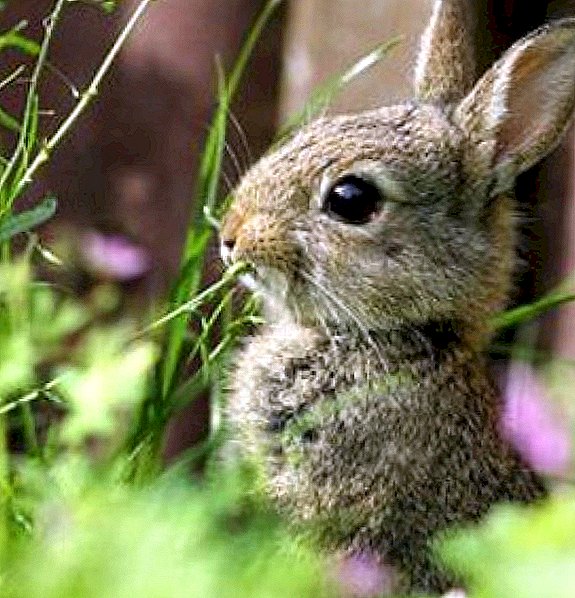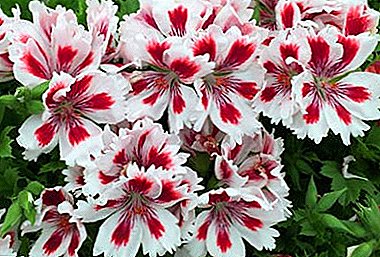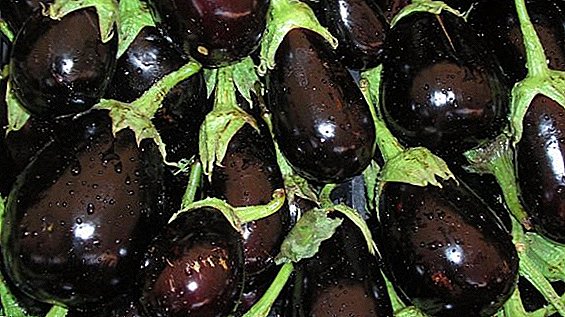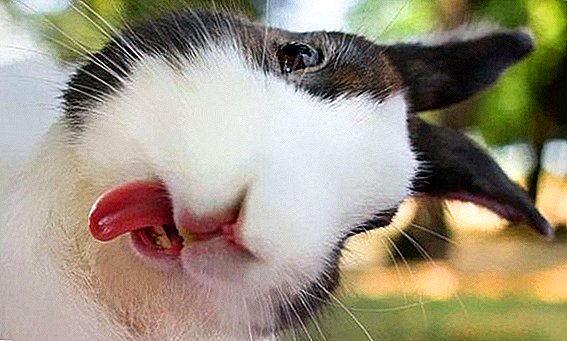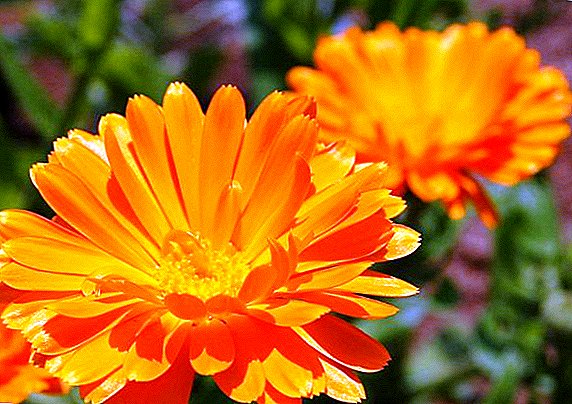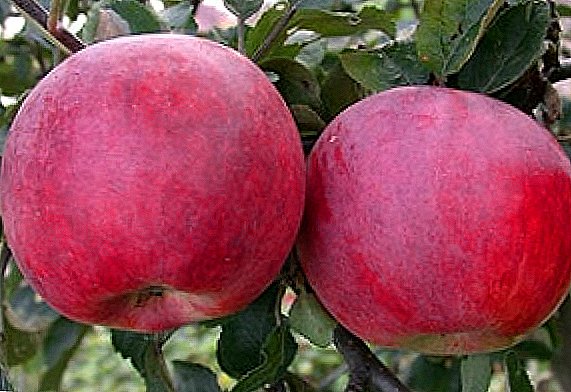 One of the most popular crops in country gardens is cucumbers. To date, there are many decent varieties of vegetables, which are good and fresh, and in the winter harvest. In this article we will discuss the variety "Pickled", whose name speaks for itself.
One of the most popular crops in country gardens is cucumbers. To date, there are many decent varieties of vegetables, which are good and fresh, and in the winter harvest. In this article we will discuss the variety "Pickled", whose name speaks for itself.
Variety description
A variety of medium early ripening, not too branched, with a thick central stem and large leafy plates, streaked with veins. The variety is indeterminate, but is intended for cultivation in open areas. “Pickling” refers to monoecious plants, but the ovaries form only female flowers. For pollination bush need insects.
Familiarize yourself with the varietal characteristics of cucumbers "Chinese Miracle", "Murom", "Buyan", "Claudia", "Murashka", "Sheaf Splendor", "Green Stream", "Bouquet", "Paratunka", "Shosh", "Aquarius "," Berendey "," Spino ".
 Among the advantages of the variety are the following:
Among the advantages of the variety are the following:
- not afraid of shading;
- resistant immunity to most pumpkin diseases;
- unpretentious care;
- excellent germination;
- seedlings adapt easily after transplanting;
- excellent flowering and fruit ovary;
- excellent fruit taste;
- high yield.
The only drawback is the short shelf life and low preservation of the presentation during transport.
Did you know? Cucumbers are grown for more than six thousand years, and they come from India, from subtropical and tropical areas at the foot of the Himalayan mountains.
Fruit characteristics and yield
The variety ripens quite early - after the emergence of shoots, the crop can be harvested for 40-45 days. The estimated collection time is July-August, depending on the region. The yield of a variety is on average 5 kilograms from an area of 1 square meter.
The fruits have the shape of an elongated oval, with a uniform thickness at both ends, sizes from 9 to 14 cm, weight up to 120 grams. On the surface of the thin skin there are many pronounced hillocks with a black center.

The pulp is aromatic, juicy, without bitterness, which makes it possible to use it in fresh salads. There is a pleasant crunch and a peculiar sourness, not lost after marinating. A positive quality is that when overriding the skin of the cucumber does not turn yellow.
Selection of seedlings
It is better to buy seedlings in the nursery: in this case, there is confidence that it corresponds to the declared name of the variety. Planting is suitable for seedlings at the age of three weeks, with a pair of strong leaves, a thick central stem and a rich green color.
Learn what seed germination depends on, how to plant cucumbers for seedlings, how to feed cucumbers during flowering and fruiting, how to seed cucumbers, how to use a trellis grid for cucumbers, how to water cucumbers, whether you need to cut the leaves of cucumbers.
On the green part of the seedlings there should be no damage and dark spots, the roots should be wet. The optimum height of a sapling is 30 cm.
Soil and fertilizer
Nutritious, drained, loose soil with a neutral or slightly alkaline reaction is suitable for growing cucumbers. This may be loam. The best precursors for the culture are onions, potatoes, peppers.

The soil is prepared twice:
- in autumn, when digging, organic materials are applied - manure, compost, a square bucket of fertilizer per meter. The soil is cleaned from all plant residues and weeds;
- In the spring, when pre-sowing cleaning and processing, mineral compounds are applied according to the instructions.
Growing conditions
Cucumbers are of tropical origin, so they love heat and moisture. The soil in which the crop grows should not dry out, nor is it advisable for cucumbers to grow in the shade. Although this variety feels rather well with a slight shading, it is better to choose for it an area covered from drafts and an illuminated area.
Growing from seed to seedlings at home
Most gardeners prefer to grow their own seedlings, as in this case there are more chances to get a healthy, productive seedling.
Did you know? The doctors of the ancient world Dioscorides, Theophrastus, and after them, Avicenna recommended the fruits as a therapeutic agent for diseases of the liver and stomach.

Seed preparation
Before planting, seeds are processed to reject soothers. Planting material is soaked in a low-saline solution, remove the seeds that float to the surface. Those that fell to the bottom of the tank, dried for about four hours (it is very important not to overdry).
Content and location
Cucumber seedlings do not like transplantation, it is fragile and can break in the process, so it is grown in peat or plastic cups, which are placed in a spacious container, for example, in a box.
Seed planting process
When planted in plastic, a special soil mixture is prepared that will protect seedlings from viruses and strengthen their immune system: peat, mullein, sawdust in a ratio of 3: 0.5: 1. The seed is buried by 2 centimeters, then the capacity with crops is covered with a film. The approximate temperature before the appearance of sprouts is + 25 ° C. After germination, it is lowered to + 18 ° C, otherwise the seedlings will stretch.
Planting cucumbers for seedlings: video
Care of seedlings
Seedlings are placed in a warm and lighted place, in the evening dosvechivayut artificial lamps. It is necessary to ensure that the humidity is about 75%, and the soil does not dry out. To do this, the soil is sprayed with a spray gun twice a week.
When a second pair of leaves appear, they feed the plant for seedlings according to the instructions. It is also necessary to prune sprouts from the direct rays of the sun, if the box is on the windowsill.
Dive saplings are not worth it, you need to remove weak shoots, leaving between them a distance of 5-7 centimeters.
A week before transplanting to the site, seedlings are adapted to the conditions of open ground. The box is carried out to fresh air, gradually increasing the “walk” time.
Transplanting seedlings to ground
Depending on the weather conditions in the region, the time of transplantation is April-May, the main condition is the absence of the risk of return frost.

Planting is carried out in the afternoon, preferably a couple of days after the rain, so that the soil gives off heat and moisture. Between plants leave a distance of 30 cm, between rows - 70 cm.
Important! When grown by the seedling method, the first fruits can be obtained a week or two earlier than when using the seed method.
Agrotechnics growing seeds in open ground
In the southern regions you can not engage in the cultivation of seedlings, and plant seeds in seeds immediately in open ground.
Outdoor conditions
Variety "Pickled" is intended for cultivation in open ground: since the culture is pollinated by bees, growing in a greenhouse will be extremely difficult. For planting seeds in open ground, choose a quiet, not accessible to the winds place, a little on a hill and open to the sun.
Learn which cucumber varieties are best planted in open ground.
The process of planting seeds in the ground
Sowing on the site is carried out at a stable daytime temperature not lower than + 15 ° C and night - not lower than + 8 ° C. To ensure the required microclimate for the seeds, a bed with greenhouse conditions is arranged a week before the intended sowing: plant garbage (grass, branches) is poured into a ditch half a meter deep and about 20 centimeters wide, covered with a thick film.
The process of arranging the warm beds: video
After a week, holding the palm above the surface, you can feel the outgoing heat. The ditch is covered with soil for 30 centimeters, no less, otherwise the roots of the sprouted shoots will burn from overheating.
Next, make a recess for seeds up to 2 cm and put two seeds in one hole, while the distance between the pits is half a meter. Then the crops are covered with a film, which will be removed after the appearance of two pairs of leaves.
Watering
Ideally, cucumbers need regular rainfall: not heavy rains every two to three days. Therefore, in the absence of such conditions, cucumbers are watered frequently, but moderately. Regular irrigation will depend on the soil moisture: it should be wet to a depth of 15 cm. It is better to take warm water, preferably rainwater, the procedure is carried out in the evening.
Important! With daily watering in sunny weather, there is a risk of burns resulting from leaves from evaporation of trapped water droplets.
Soil loosening and weeding
After irrigation, loosening is carried out to saturate the soil with oxygen. The root system of culture is located at a depth of about 20 centimeters - when loosening it must be taken into account in order not to damage the roots.

Since the root system of cucumbers can not compete with weeds for food, you need to regularly weed the beds of culture, removing unwanted neighbors.
Masking
Since indeterminate varieties have no growth restriction, they are grown more often by the trellis method. In this case, the formation of a plant in one trunk is ideal.
The central whip will grow upwards, all its ovaries and future fruits will be located on the same line, which will facilitate harvesting. With this formation, lateral shoots are removed with the ovaries.
Garter
For tying "Pickle" set the tapestry of wooden stakes and stretched between them a thin twine or string. In addition to accuracy and convenience, this method of growing prevents waterlogging in plantings, which can lead to the appearance of fungi and bacteria.

Top dressing
The variety is fed twice per season. During the period of green growth, a mixture of ammonium nitrate and potassium chloride (4 grams), superphosphate (10 grams) per ten liters of water is prepared. During the period of formed ovaries they feed with the same solution, but with a dosage doubled by the same amount of water.
Pests, diseases and prevention
Pumpkin diseases are false powdery mildew, powdery mildew, olive spot, root rot.
Drugs that are sprayed for treatment:
- "Allirin-B";
- "Fitosporin-M";
- "Oxy".

Pests that can attack ogrutsy:
- aphid (drug - "Akarin");
- spider mite ("Fitoverm", "Fufanon");
- whitefly ("Aktellik", "Confidor").
Harvesting and storage
Harvest since July. The fruits ripen at the same time, so you need to watch them. Fruits are carefully separated from the stalk, leaving it on the shoot, it is best to cut with a sharp knife.
Since the variety is bred for canning, the fruit is harvested when it reaches 10 cm in length, which is convenient when placed in a jar. Harvesting is carried out in the evening during dry weather, plucked fruit laid in the shade.
Check out the recipes for cucumbers with mustard seeds, chili ketchup, cucumbers in Korean, sliced cucumbers for the winter, pickled, lightly salted, crispy cucumbers.
These cucumbers are not stored fresh for more than a week, they need not be washed and placed in a refrigerator.

Possible problems and recommendations
Possible problems with the plant are as follows:
- dry leaves and ovaries, fall;
- voids are formed in the fruit.
Find out why the leaves of cucumbers turn white, turn yellow, turn yellow and dry, fade cucumbers, what to do with midges on cucumbers, what to do so that cucumbers are not bitter, why the ovaries of cucumbers turn yellow.
Causes of such problems:
- temperature drops and lack of shelter at this time;
- excess feedings, especially nitrogen;
- nutritional deficiencies;
- root disease;
- insufficient moisture.
Cucumber varieties "Zasolochny" deserved high reviews of summer residents and hostesses: the fruits are ideal for all types of winter preservation, including salads, you can also use them fresh. To achieve a good harvest is not difficult, you just need to comply with the conditions of the culture.
Video: brief description of the pickled cucumber variety





